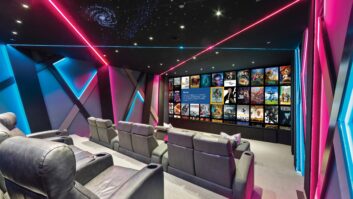Suppliers will fly into next month’s CES, here, with the goal of boosting the average selling price of home theater in a box (HTiB) systems, whose dollar sales have remained almost flat this year despite double-digit unit-sales gains.
Suppliers will also struggle to make two-channel CD shelf systems more relevant in an age of compressed music, DVD and PCs.
At CES, dealers will find HTiB suppliers raising performance levels, adding PVRs and DVD recorders, making connections to PCs and portable MP3 players, offering cosmetics that complement consumers’ homes and TVs, and adding technologies that make systems easier to operate and enjoy, including component-video up-conversion.
In shelf systems, Philips will reveal more details of its Wireless Audio System WACS700, a one-piece minisystem that plays back music stored on an internal HDD and distributes that music wirelessly multiple amplified one-piece minisystem-style clients.
- at least one supplier will bundle a shelf system with an MP3 portable to transfer music direct from CD to the portable.
- and at least one more company will offer systems with DVD-Video players, joining JVC and Panasonic in this market.
- In home theater systems:
- at least one company will join Panasonic in offering HTiBs that incorporate both a DVD recorder and HDD PVR.
- at least three companies will unveil their first systems with HDMI outputs that upscale DVD video to high-definition.
- one company will unveil HTiBs that connect to multiple brands of MP3 portables to play back the portables’ music, control song selection via a connected TV’s remote, and rip/encode CDs for transfer to MP3 portables.
- suppliers will eliminate speakers to make more room for their systems in consumers’ home. Two companies, for example, will show their first systems with main left-right speakers that deliver surround channels.
- More systems will use wireless to eliminate front-to-back speaker-cable runs.










